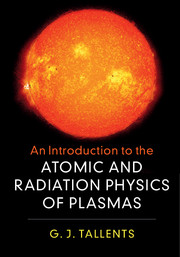Book contents
- Frontmatter
- Contents
- Preface
- 1 Plasma and Atomic Physics
- 2 The Propagation of Light
- 3 Scattering
- 4 Radiation Emission in Plasmas
- 5 Radiation Emission Involving Free Electrons
- 6 Opacity
- 7 Discrete Bound Quantum States: Hydrogen and Hydrogen-Like Ions
- 8 Discrete Bound States: Many-Electron Atoms and Ions
- 9 Discrete Bound States: Molecules
- 10 Radiative Transitions between Discrete Quantum States
- 11 Collisions
- 12 Collisional-Radiative Models
- 13 High-Density Plasmas
- Appendix Vectors, Maxwell's Equations, the Harmonic Oscillator and a Sum Rule
- References
- Index
6 - Opacity
Published online by Cambridge University Press: 21 February 2018
- Frontmatter
- Contents
- Preface
- 1 Plasma and Atomic Physics
- 2 The Propagation of Light
- 3 Scattering
- 4 Radiation Emission in Plasmas
- 5 Radiation Emission Involving Free Electrons
- 6 Opacity
- 7 Discrete Bound Quantum States: Hydrogen and Hydrogen-Like Ions
- 8 Discrete Bound States: Many-Electron Atoms and Ions
- 9 Discrete Bound States: Molecules
- 10 Radiative Transitions between Discrete Quantum States
- 11 Collisions
- 12 Collisional-Radiative Models
- 13 High-Density Plasmas
- Appendix Vectors, Maxwell's Equations, the Harmonic Oscillator and a Sum Rule
- References
- Index
Summary
The opacity of a medium is its impenetrability to radiation. For electromagnetic radiation in plasmas, the opacity arises due to absorption by free and bound electrons or due to scattering (where some radiation is re-emitted). We discussed scattering in Chapter 3, absorption of radiation in Chapter 4 and the particular physics of absorption by free electrons in Chapter 5.
Radiation opacity in plasma is important at higher densities or in larger plasmas. However, even low-density plasma may have some frequencies of radiation, say in the microwave or radiofrequency spectral range where radiation absorption is significant. Plasma opacity can limit the ability to diagnose conditions within the interior of a plasma and plasma opacity can slow the outflow of energy within a plasma and lead to non-local radiation heating.
Radiation transport calculations use a measure of dimensionless distance known as the optical depth. The optical depth of a thickness of material is the natural logarithm of the ratio of the incident to transmitted radiation power through the material. In the absence of any source of radiation, the radiation power falls exponentially with optical depth. When the optical depth approaches zero, a medium is said to be optically thin for the specified radiation and the opacity can be neglected. Large values of optical depth #x226B; 1 for a plasma or other medium suggest that opacity and radiation transport is significant: a condition known as ‘optically thick’.
We explore in this chapter the issue of opacity and the movement of radiation energy in plasmas. After some general treatment of opacity, we consider plasmas which are in, or close to, thermal equilibrium, so that the radiation field can be described by the Planck black-body distribution. Opacity modeling and radiation transport in plasmas close to thermal equilibrium is important in solar and stellar radiation modelling and in laser-produced plasmas.
The Equation of Radiative Transfer
The radiation intensity within a plasma exchanges energy with the bound and free electrons by emission and absorption processes. Electron transitions between bound discrete quantum states associated with the energy states of an ion or atom produce spectral-line emission, while transitions from free electrons to other free quantum states or to bound quantum states produce continuum emission.
Information
- Type
- Chapter
- Information
- An Introduction to the Atomic and Radiation Physics of Plasmas , pp. 113 - 126Publisher: Cambridge University PressPrint publication year: 2018
